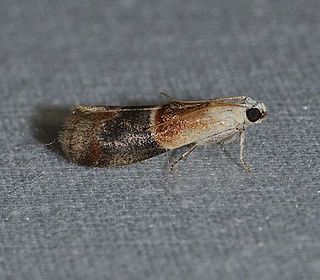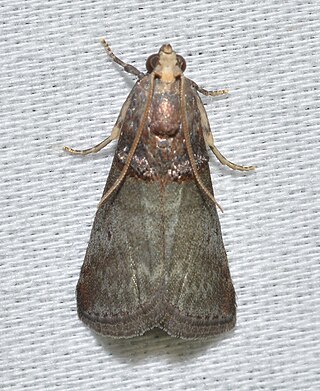
Crambidae comprises the grass moth family of lepidopterans. They are variable in appearance, with the nominal subfamily Crambinae taking up closely folded postures on grass stems where they are inconspicuous, while other subfamilies include brightly coloured and patterned insects that rest in wing-spread attitudes.

Carya laciniosa, the shellbark hickory, in the Juglandaceae or walnut family is also called kingnut, big, bottom, thick, or western shellbark, attesting to some of its characteristics. It is a slow-growing, long-lived tree, hard to transplant because of its long taproot, and subject to insect damage. The nuts, largest of all hickory nuts, are sweet and edible. Wildlife and people harvest most of them; those remaining produce seedling trees readily. The wood is hard, heavy, strong, and very flexible, making it a favored wood for tool handles. A specimen tree has been reported in Missouri with 117 cm (46 in) diameter at breast height, 36.9 m tall, and a spread of 22.6 m.

Carya tomentosa, commonly known as mockernut hickory, mockernut, white hickory, whiteheart hickory, hognut, bullnut, is a species of tree in the walnut family Juglandaceae. The most abundant of the hickories, and common in the eastern half of the United States, it is long lived, sometimes reaching the age of 500 years. A straight-growing hickory, a high percentage of its wood is used for products where strength, hardness, and flexibility are needed. The wood makes excellent fuel wood, as well. The leaves turn yellow in Autumn.

Carya aquatica, the bitter pecan or water hickory, is a large tree, that can grow over 30 metres (98 ft) tall of the Juglandaceae or walnut family. In the American South it is a dominant plant species found on clay flats and backwater areas near streams and rivers. The species reproduces aggressively both by seed and sprouts from roots and from stumps of cut trees. Water hickory is a major component of wetland forests now in the south eastern US, because of the selective cutting of more desirable tree species for the lumber industry. It is considered important in cleansing drainage waters since the plants slow water flow during flooding, allowing sediments to fall out of the water column. This tree species is tolerant of wet soils but grows best on well draining soils near rivers and other water ways.

Acrobasis is a genus of moths of the family Pyralidae.

Acrobasis demotella, the walnut shoot moth, is a moth of the family Pyralidae described by Augustus Radcliffe Grote in 1881. It is found in North America, from Ontario south to North Carolina and west to Missouri and Michigan.
Acrobasis cunulae is a species of snout moth in the genus Acrobasis. It was described by Harrison Gray Dyar Jr. and Heinrich, in 1929, and is known from Ontario, Canada, and eastern United States.

Acrobasis caryivorella, the pecan nursery casemaker, is a species of snout moth in the genus Acrobasis. It was described by Émile Louis Ragonot in 1887, and is known from southeastern Ontario, Canada, and the eastern United States.
Acrobasis kearfottella, Kearfott's acrobasis moth, is a species of snout moth in the genus Acrobasis. It was described by Harrison Gray Dyar Jr. in 1905, and is known from Quebec, Canada, and the eastern United States.

Acrobasis caryalbella is a species of snout moth in the genus Acrobasis. It was described by Charles Russell Ely in 1913 and is known from the eastern United States.

Acrobasis palliolella, the mantled acrobasis moth, is a species of snout moth in the genus Acrobasis. It was described by Ragonot in 1887, and is known from Ontario, Canada, and the eastern United States.
Acrobasis latifasciella is a species of snout moth in the genus Acrobasis. It was described by Harrison Gray Dyar Jr., in 1908, and is known from the northeastern United States.

Acrobasis stigmella is a species of snout moth in the genus Acrobasis. It was described by Harrison Gray Dyar Jr. in 1908, and is known from Ontario, Canada, and the eastern United States.
Acrobasis caulivorella is a species of snout moth in the genus Acrobasis. It was described by Herbert H. Neunzig in 1986, and is known from Florida, United States.
Acrobasis evanescentella is a species of snout moth in the genus Acrobasis. It was described by Harrison Gray Dyar Jr., in 1908, and is known from southern Georgia and Florida.
Acrobasis elyi is a species of snout moth in the genus Acrobasis. It was described by Herbert H. Neunzig in 1970, and is known from Connecticut to Florida in the United States.

Acrobasis caryae, the hickory shoot borer, is a species of snout moth in the genus Acrobasis. It was described by Augustus Radcliffe Grote in 1881, and is known from southeastern Ontario, Canada, and the eastern United States.

Acrobasis tricolorella, the destructive prune worm or tricolored acrobasis moth, is a species of snout moth in the genus Acrobasis. It was described by Augustus Radcliffe Grote in 1878, and is known from southern Canada and northern United States.

Acrobasis indigenella, the leaf crumpler, is a species of snout moth in the genus Acrobasis. It was described by Philipp Christoph Zeller in 1848, and is known from eastern North America.













